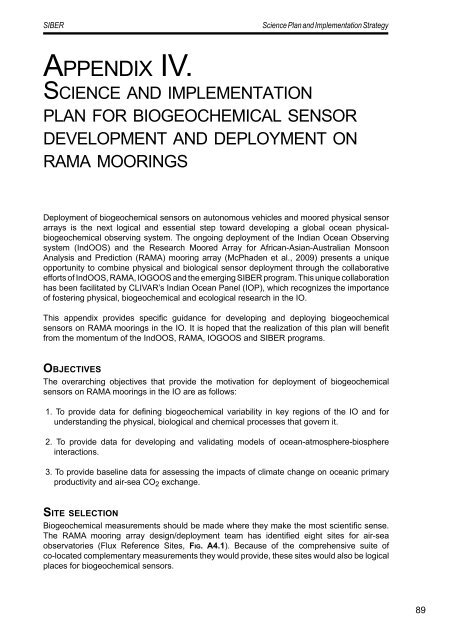SIBER SPIS sept 2011.pdf - IMBER
SIBER SPIS sept 2011.pdf - IMBER
SIBER SPIS sept 2011.pdf - IMBER
Create successful ePaper yourself
Turn your PDF publications into a flip-book with our unique Google optimized e-Paper software.
<strong>SIBER</strong><br />
Science Plan and Implementation Strategy<br />
Ap p e n d i x IV.<br />
Sc i e n c e a n d i m p l e m e n t a t i o n<br />
p l a n f o r b i o g e o c h e m i c a l s e n s o r<br />
d e v e l o p m e n t a n d d e p l o y m e n t o n<br />
r a m a m o o r i n gs<br />
Deployment of biogeochemical sensors on autonomous vehicles and moored physical sensor<br />
arrays is the next logical and essential step toward developing a global ocean physicalbiogeochemical<br />
observing system. The ongoing deployment of the Indian Ocean Observing<br />
system (IndOOS) and the Research Moored Array for African-Asian-Australian Monsoon<br />
Analysis and Prediction (RAMA) mooring array (McPhaden et al., 2009) presents a unique<br />
opportunity to combine physical and biological sensor deployment through the collaborative<br />
efforts of IndOOS, RAMA, IOGOOS and the emerging <strong>SIBER</strong> program. This unique collaboration<br />
has been facilitated by CLIVAR’s Indian Ocean Panel (IOP), which recognizes the importance<br />
of fostering physical, biogeochemical and ecological research in the IO.<br />
This appendix provides specific guidance for developing and deploying biogeochemical<br />
sensors on RAMA moorings in the IO. It is hoped that the realization of this plan will benefit<br />
from the momentum of the IndOOS, RAMA, IOGOOS and <strong>SIBER</strong> programs.<br />
Obj e c t i v e s<br />
The overarching objectives that provide the motivation for deployment of biogeochemical<br />
sensors on RAMA moorings in the IO are as follows:<br />
1. To provide data for defining biogeochemical variability in key regions of the IO and for<br />
understanding the physical, biological and chemical processes that govern it.<br />
2. To provide data for developing and validating models of ocean-atmosphere-biosphere<br />
interactions.<br />
3. To provide baseline data for assessing the impacts of climate change on oceanic primary<br />
productivity and air-sea CO 2 exchange.<br />
Sit e se l e c t i o n<br />
Biogeochemical measurements should be made where they make the most scientific sense.<br />
The RAMA mooring array design/deployment team has identified eight sites for air-sea<br />
observatories (Flux Reference Sites, Fig. A4.1). Because of the comprehensive suite of<br />
co-located complementary measurements they would provide, these sites would also be logical<br />
places for biogeochemical sensors.<br />
89












